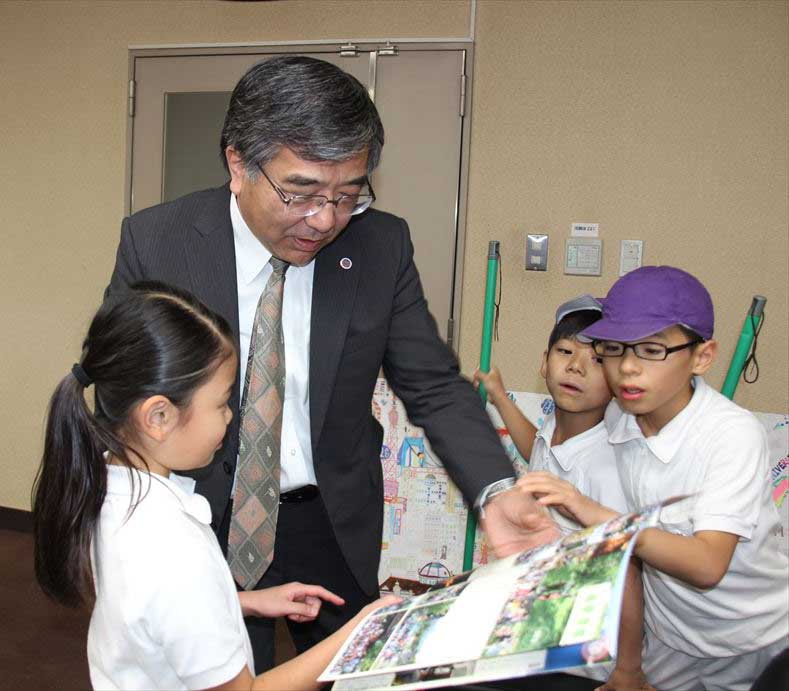TSUKUBA FRONTIER
#16 The Joy of Studying Together: Searching for the Essence of Education Created by People
It is not uncommon for a teacher to determine whether one loves or hates a particular subject. Teaching methods and general manner depend on affinity, so there is no single kind of "good teacher." Professor Katahira's aim is to understand how learning is undertaken in the classroom and to examine, from a meta-perspective, methods which will expedite furthering the abilities of learners.
Professor KATAHIRA Katsuhiro, Faculty of Human Sciences

■ People can change education
Primary and secondary education are important learning environments which have a great influence on later life. Within this, the role of the teacher is far more than teaching the curriculum; it encompasses a broad range of tasks such as guidance in life attitudes and teamwork. A teacher must build individual relationships with each student, while at the same time interacting with the group as a whole. Outcomes in any given subject are greatly influenced by the teacher and the teaching methods.
It is often said that education changes people. But in reality, people encountered in the home and at school deeply affect the major premises of education. Far more than environment and facilities, it is people who arouse the desire to learn. In this sense, it is definitely true that people can change education.
■ From educator to observer
It was very natural for Prof. Katahira to choose to become an educator as his parents and grandfather were all teachers. With his newly-acquired teaching license in hand, he began his career as a science teacher in a junior high and a high school. He enjoyed teaching and was proud of his job, but as a young teacher he found the burden of dealing with discipline and truancy to be too heavy. Therefore, he decided to return to graduate school to study education more deeply.
Education research uses ethnomethodological techniques (i.e. the analysis of the processes which create order within a group) to build up case studies of practical lessons, and then extract the best teaching methods. It is difficult for a teacher to simultaneously observe each individual student while conducting a lesson, so a third-party researcher observes the entire class metacognitively. In this way, the true effects of the lesson become visible.
In science, certain creativity is required for the design of teaching materials as experiments and observation are extremely important activities. To open the door to the world of science, the children's interest and concentration have to be aroused and maintained through the use of familiar items and materials, and the implementation of various tools which include elements of play. However, well-thought-out materials do not necessarily achieve the intended results. Lesson observation often identifies areas for improvement in teaching materials.
■ Coordinating in education
The results of class observation are then applied in subsequent lessons. However, each class has its own character, and the teacher's performance and the classroom environment are continually changing. There is no universal optimum way to conduct a lesson. The situation at any given moment must be judged, and the lesson plan has to be adjusted accordingly to achieve the best possible teaching.
This ability to adjust plans spontaneously is a skill all the best teachers possess. Just as an orchestral conductor beats time to create harmonious music, the guidance given by a teacher enables the teacher to collaborate with the students to build a lesson, in other words, the ability to "beat time" in education is the key to the success or failure of a lesson.
In order to improve teaching methods and lesson management, the teacher needs to gain experience, master a range of coordinating and "conducting" techniques, and develop the instinct to implement each technique as and when it is required. The eye of the lesson observer--the education researcher, has the special ability to deduce guiding principles for this.
■ Toward collaborative education
 Active or shared learning has garnered a great deal of attention in recent years. However, simply doing everything together does not mean that learning is automatically achieved. The significance of sharing and collaboration only becomes apparent if things are carefully thought about in advance and reflected on afterward. Even if it appears that learners are examining things individually, spending this time alongside each other and together with the teacher is the greatest support.
Active or shared learning has garnered a great deal of attention in recent years. However, simply doing everything together does not mean that learning is automatically achieved. The significance of sharing and collaboration only becomes apparent if things are carefully thought about in advance and reflected on afterward. Even if it appears that learners are examining things individually, spending this time alongside each other and together with the teacher is the greatest support.
The same is true for university seminars. The themes are on a higher level, and there are more cases in which clear answers may not be found, and this can lead to silence in the room. But this is exactly what shared learning is. These times may be tough for students, but there is no greater joy than to bat ideas around together and find answers. These moments encourage the students to find the direction in which they want to proceed.
The role of the teacher is to construct a springboard from which learners can gradually improve their abilities, but a more important aspect is the appropriate timing for when this springboard should be pulled out from under. A building cannot be considered complete until after the scaffolding has been removed. When a certain stage is reached, responsibility for learning is transferred to the learner. This is how a person grows into an independent learner. While relishing the fun of collaborative learning, teachers must watch over their students' progress with an affectionate but firm eye.
Article by Science Communicator at the Office of Public Relations


